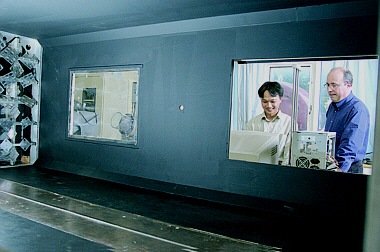Unraveling the Mystery of Turbulence

Professor Charles Meneveau, right,
and doctoral student Yi Li inspect a Homewood campus wind
tunnel, where turbulence experiments are
conducted.
PHOTO BY HIPS/WILL KIRK
|
New formula could help better predict weather and water
movement
By Phil Sneiderman
Homewood
To most people, turbulence is the jolt felt by jet
passengers moving through a rough pocket of air. But to
scientists, turbulence is the chaotic flow of a gas or
liquid in which parts of the current curl into irregular,
ever smaller, tight eddies. It's a very common phenomenon
that can affect weather conditions, greatly alter the
movement of pollutants, dampen a vehicle's speed or play a
role in the way chemicals mix and combustion engines
perform. Yet the phenomenon is difficult to understand, and
scientists cannot easily predict how a turbulent flow will
behave.
While working on this problem, researchers at Johns
Hopkins have discovered a new mathematical formula that
could lead to more precise computer models describing
turbulent flow.
Charles Meneveau, who last week was named the Louis M.
Sardella Professor in
Mechanical Engineering, and Yi Li, a doctoral student
in the department, unveiled the formula, called the
"advected delta-vee equation," in a paper published Oct. 14
in the journal Physical Review Letters.
"This equation gives us a mathematical shortcut to
describe a complex characteristic of turbulence called
intermittency," said Meneveau, who also is director of the
Center for
Environmental and Applied Fluid Mechanics at Johns
Hopkins. "It solves just one piece of the overall
turbulence puzzle, but it's a very important piece."
Intermittency refers to abrupt, very concentrated
changes in the speed of a moving fluid. If the velocity of
a fluid is plotted on a graph, these changes look like
sharp drop-offs or cliffs rather than smooth, gentle
slopes. These sharp changes are said to be intermittent
because they occur infrequently within a turbulent flow,
but when they do, they can be quite violent.
This characteristic has been particularly tough to
include in computer models of turbulence because
representing it numerically requires a huge number of
calculations and a mammoth amount of computing power.
"Conceptually, we could do it," Meneveau said. "But it's
not practical."
Meneveau and Li devised a shortcut by tracking two
particles as they moved with a turbulent flow like two
balloons tossed along by a gust of wind. The resulting
equation gave them a tool to predict intermittency by
merely solving this simple equation rather than having to
solve complicated computer models of turbulence.
"Ultimately, we believe this will help researchers put
together more precise models that could be used to predict
weather patterns, movement within bodies of water and even
some turbulent events that take place within an internal
combustion engine," Meneveau said. "Astrophysicists are
also interested in this because, for instance, magnetic
fields in interplanetary space demonstrate turbulencelike
intermittent features."
He and his students have been conducting their own
measurements of turbulence and intermittency in a wind
tunnel located on the Homewood campus. Wind tunnel
experiments allow them to gather data to provide ideas for
better computer models and help them verify that
predictions from these models match up with real-world
results.
Funding for Meneveau and Li's research has been
provided by the National Science Foundation and the Office
of Naval Research.

Related Web Sites
Charles Meneveau's Web page
Johns Hopkins Center for Environmental and Applied Fluid
Mechanics
 GO TO OCTOBER 24,
2005
TABLE OF CONTENTS.
GO TO OCTOBER 24,
2005
TABLE OF CONTENTS.
 GO TO THE GAZETTE
FRONT PAGE.
GO TO THE GAZETTE
FRONT PAGE.
|